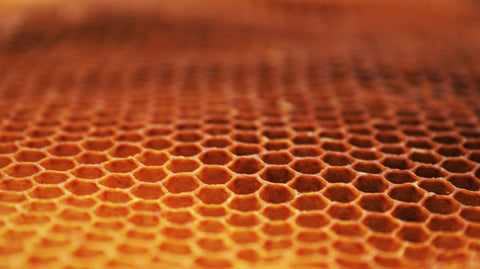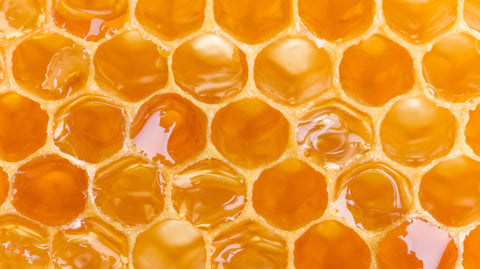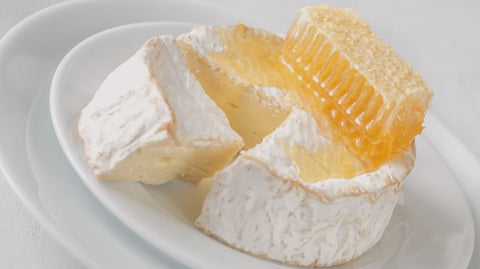Honeycomb is a structure built by honey bees in their hives, consisting of six-sided wax cells that store honey, pollen, and bee larvae. These hexagonal cells are a natural, efficient way for bees to store their food and rear their young. The entire structure, including the wax cells and the honey they contain, is edible.
Honeycomb is one of nature’s most fascinating and functional creations. Built entirely by bees, this golden, waxy structure is made up of perfect hexagonal cells that store honey, pollen, and even baby bees. But beyond its practical use in the hive, honeycomb captures the imagination of humans for its beauty, complexity, and delicious taste. Whether you’ve seen it dripping with fresh honey at a farmers market or featured on a charcuterie board, honeycomb is both a scientific wonder and a sweet indulgence.
In this blog, we’ll explore exactly what honeycomb is, how bees create it, and why its unique hexagonal design is so important. You’ll also learn about the edible side of honeycomb, its health benefits, and how people use it beyond just eating it. Whether you're a curious foodie, nature lover, or someone looking to better understand the magic behind honey, this guide will give you a fresh appreciation for the bees’ incredible work.
What Is Honeycomb?
Honeycomb is a natural structure made by honeybees from beeswax, formed into a pattern of tightly packed hexagonal cells. These cells serve multiple functions within the hive: they hold the colony’s honey stores, provide space for pollen storage, and act as cradles for developing larvae. Bees use their own wax, produced by glands on their abdomens, to construct this intricate and efficient matrix, which can be expanded endlessly as the hive grows.
What makes honeycomb particularly fascinating is its geometric precision. The hexagon is not just beautiful; it’s an incredibly efficient shape that allows bees to store the maximum amount of honey using the least amount of wax.
This efficiency means the hive can stay lightweight while remaining structurally strong and organized. Honeycomb isn't just functional, it’s an architectural marvel that reflects both the intelligence of bee behavior and the ingenuity of nature’s design.
How Do Bees Make Honeycomb?
The process of making honeycomb begins with worker bees, specifically the younger ones, known as “builder bees”, who are responsible for producing beeswax. These bees consume honey and convert the sugars into wax through special glands on their abdomens. The wax is secreted as tiny flakes, which the bees then chew and soften with their mandibles until it becomes pliable enough to mold. Working together, the bees meticulously form the wax into thin walls that make up the honeycomb’s iconic hexagonal pattern.
Building honeycomb is a highly cooperative effort that requires both precision and teamwork. Bees maintain the structure’s temperature around 95°F to keep the wax soft and workable. Using their bodies as measuring tools, they shape each cell uniformly, creating perfect hexagons without the need for tools or blueprints.
This remarkable instinct-driven process allows the hive to expand quickly and efficiently, providing the foundation for honey storage, brood rearing, and the overall health of the colony.
Is Honeycomb Edible?
Yes, honeycomb is completely edible, wax and all! When you bite into a piece of honeycomb, you’ll experience a satisfying burst of raw honey followed by the soft, chewy texture of beeswax.
The honey inside the comb is often considered purer and more flavorful than processed honey, as it hasn’t been filtered or heated. Many people enjoy eating small chunks of honeycomb on its own or pairing it with foods like cheese, fruit, or toast for a naturally sweet, gourmet touch.
In addition to its delicious taste, honeycomb offers several health benefits. Raw honey contains antioxidants, enzymes, and trace amounts of vitamins and minerals.
Benefits of Honeycomb
Honeycomb isn’t just a delicious treat, it also offers a variety of natural health benefits. The raw honey contained within the comb is packed with antioxidants, including flavonoids and phenolic acids, which may help reduce inflammation and support a healthy immune system.
Unlike processed honey, raw honey straight from the comb retains its natural enzymes, vitamins, and trace minerals, making it a nutrient-rich alternative to refined sweeteners.
Beeswax, the chewy substance that forms the structure of the honeycomb, also has potential health perks. It contains long-chain fatty acids and alcohols that may support heart health and digestion. While honeycomb is generally safe for most people, it should be eaten in moderation, and avoided by infants under one year old due to the risk of botulism from raw honey.
Uses for Honeycomb Beyond the Hive
While honeycomb plays a vital role inside a beehive, it also has many uses outside of it, ranging from culinary delights to natural wellness products. Thanks to its unique texture, sweet flavor, and natural wax, honeycomb has become a popular ingredient and material in homes and industries alike.
Here are some of the most common and creative uses for honeycomb beyond the hive:
-
Culinary Delicacy: Add chunks to charcuterie boards, salads, or atop warm toast for a gourmet touch.
-
Natural Sweetener: Use it as a wholesome alternative to processed sugars in baking or tea.
-
Skincare Products: Beeswax from honeycomb is used in lip balms, lotions, and moisturizers for its hydrating and protective properties.
-
Candle Making: Cleaned beeswax is molded into clean-burning, naturally scented candles.
- Home Remedies: Incorporated into homemade salves and ointments for soothing dry skin or minor cuts.
Whether you're a foodie, DIY enthusiast, or simply a fan of natural products, honeycomb offers a surprising number of ways to bring the hive into your home.
What's The Difference of Honeycomb and Processed Honey?
The main difference between honeycomb and processed honey lies in purity and form. Honeycomb is honey in its rawest state, straight from the hive, still sealed in beeswax cells. It hasn’t been filtered, heated, or altered in any way, which means it retains all its natural enzymes, pollen, antioxidants, and nutrients.
In contrast, processed honey often goes through pasteurization and filtration to improve shelf life and clarity, which can strip away some of its beneficial properties.
Texture and taste also set them apart. Honeycomb offers a unique experience: you get the rich sweetness of raw honey combined with the chewiness of natural wax. Processed honey, on the other hand, is smooth and pourable, making it easier to use in cooking or as a table sweetener.
While both are delicious, honeycomb provides a closer connection to nature and a more nutrient-dense option for those seeking the full benefits of honey in its purest form.
Where To Buy Real Honeycomb
If you're looking to enjoy honeycomb at home, one trusted source is Ames Farm, a Minnesota-based company known for its single-source honeycomb that's harvested straight from the hive.
Ames Farm carefully hand-cuts their comb honey, ensuring you get a pure, unfiltered product that captures the unique flavor of the flowers in bloom during each season. You can purchase their honeycomb directly from their website, and they also offer beautifully packaged gift jars, perfect for sharing or treating yourself.
Final Thoughts About Honeycomb
Honeycomb is more than just a sweet treat, it’s a testament to the ingenuity of bees and the richness of nature. From its hexagonal design and raw nutritional value to its many uses in food, wellness, and beyond, honeycomb offers something truly special for anyone who appreciates natural, wholesome living. Whether you're new to trying honeycomb or already a fan, understanding where it comes from and how it’s made adds a deeper layer of appreciation to every bite.
For those who want to experience honeycomb in its purest form, Ames Farm is a name you can trust. With a commitment to ethical beekeeping and exceptional quality, Ames Farm offers a range of honeycomb options, including seasonal varieties and beautifully packaged gift jars. You can explore their offerings and order online, bringing a taste of the hive directly to your home.
Frequently Asked Questions About Honey
Is it safe to eat the wax in honeycomb?
Yes, the beeswax in honeycomb is safe to eat. While it’s not digestible in the same way honey is, many people chew the wax like gum and either swallow it or discard it after the flavor fades.
Does honeycomb taste different from regular honey?
Yes. Honey from the comb often has a richer, more complex flavor because it’s raw and unfiltered. It may also vary slightly in taste depending on the flowers the bees visited.
How should I store honeycomb?
Store honeycomb at room temperature in an airtight container, away from direct sunlight. There’s no need to refrigerate it, and it can last for months thanks to honey’s natural preservative qualities.
What are the benefits of eating honeycomb?
Honeycomb contains raw honey rich in antioxidants, enzymes, and trace nutrients. The beeswax may also support digestive health when consumed in small amounts.



